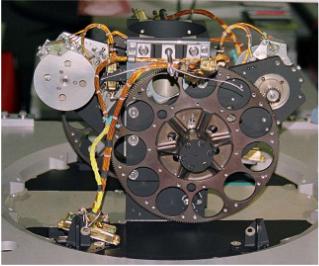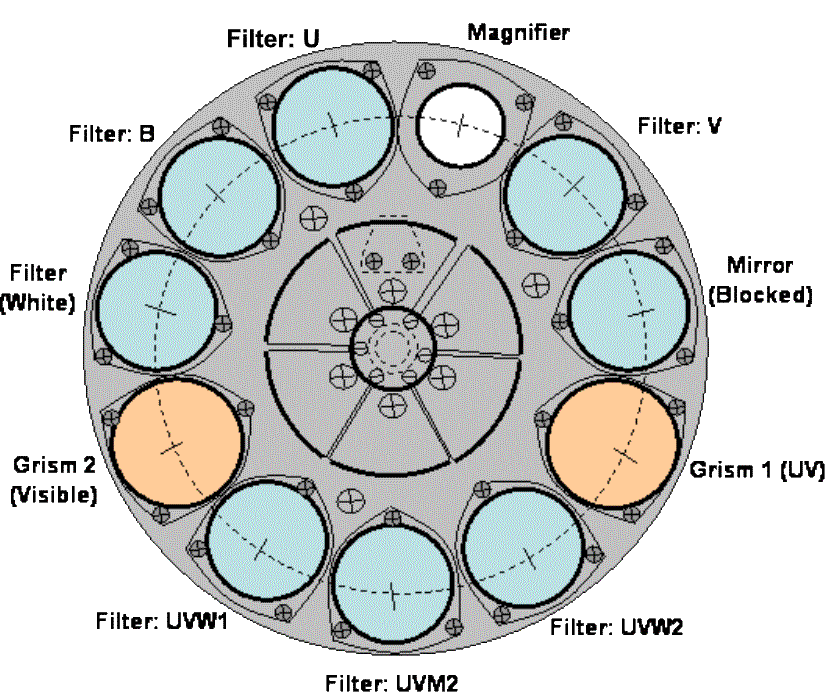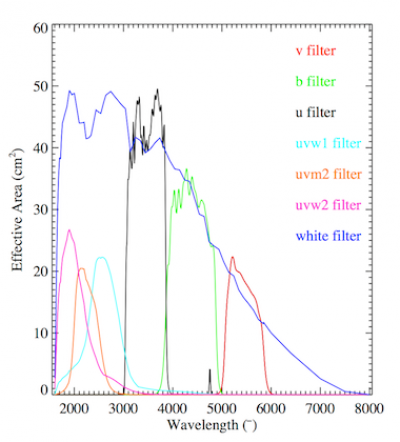 The UVOT contains 4 types of elements: filters, grisms, a magnifier and a mirror. The filters
are used to obtain optical and ultraviolet images, while the
grisms take optical and ultraviolet spectroscopic measurements. The mirror
blocks light from entering the UVOT. Light is reflected into the filterwheel from the inclined third mirror
inside the UVOT baffle.
Light passes through the chosen filter or grism on the filterwheel into the UVOT
detector.
The magnifier is no longer used due to focussing problems.
The UVOT contains 4 types of elements: filters, grisms, a magnifier and a mirror. The filters
are used to obtain optical and ultraviolet images, while the
grisms take optical and ultraviolet spectroscopic measurements. The mirror
blocks light from entering the UVOT. Light is reflected into the filterwheel from the inclined third mirror
inside the UVOT baffle.
Light passes through the chosen filter or grism on the filterwheel into the UVOT
detector.
The magnifier is no longer used due to focussing problems.
Click on a filter name for more information.
|
0. Mirror (Blocked) 1. Filter: V 2. Magnifier 3. Filter: U |
4. Filter: B 5. Filter (White) 6. Grism 2 (Visible) 7. Filter: UVW1 |
8. Filter: UVM2 9. Filter: UVW2 10. Grism 1 (UV) |

|
||
The mirror is used to block photons from entering the UVOT. This is essential when the UVOT passes through or near the light path of a bright object, such as a bright star, planet, the Sun, the Moon, or Earth.
The V filter allows optical light to pass through to the CCD with a central wavelength 546.8 nm and width 76.9 nm. Zero point (Vega) is 17.89, and point spread function has a FWHM of approximately 2.2". Top
This 4x magnifier provides enlargement of objects resulting in 0.12 arcsec pixels for near diffraction limited imaging. (The magnifier cannot be used since it is not in focus in the operational configuration). Top
The U filter allows ultraviolet light to pass through to the CCD with central wavelength 346.5 nm and width 78.5 nm. Zero point (Vega) is 18.34, and point spread function has a FWHM of approximately 2.4". Top
The B filter allows optical light to pass through to the CCD with with central wavelength 439.2 nm and width 97.5 nm. Zero point (Vega) is 19.11, and point spread function has a FWHM of approximately 2.2". Top
The white filter allows a broad spectrum of light to pass through to the CCD with a bandpass from 180 past 700 nanometers. Zero point (Vega) is 20.29, and point spread function has a FWHM of approximately 2.3" Top
The optical grism is a right-angled prism with a diffraction grating on the back side that allows optical light to pass through. The transmitted optical photons can be used to make spectroscopic measurements. The spectral resolution of the optical grism is 1 nm / pixel. The optical grism is blazed, so 0th order images are relatively weak compared with 1st order. This is not the case for Grism 1. The two grisms cannot be used simultaneously.Top
The UVW1 filter allows ultraviolet light to pass through to the CCD with a central wavelength 260.0 nm and width 69.3 nm. Zero point (Vega) is 17.49, and point spread function has a FWHM of approximately 2.4". Top
The UVM2 filter allows ultraviolet light to pass through to the CCD with central wavelength of 224.6 nm and width 49.8 nm. Zero point (Vega) is 16.82, and point spread function has a FWHM of approximately 2.5". Top
The UVW2 filter allows ultraviolet light to pass through to the CCD with a central wavelength of 192.8 nm and width 65.7 nm. Zero point (Vega) is 17.35, and point spread function has a FWHM of approximately 2.9". Top
Grism 1 (UV) The UV grism is a right-angled prism with a diffraction grating on the back side that allows ultraviolet light to pass through. The transmitted UV photons can be used to make spectroscopic measurements. The UV grism has a spectral resolution of 0.5 nm / pixel, and the unblazed grism allows approximately one third of the light into the 0th order image. This image should be visible near the edge of the field of view. The UV grism cannot be used simulataneously with the optical grism. Top
Swift-UVOT: filter effective areas.
For further information on the filters and their effective areas please see the 'filter set' in the UVOT catalogue pages
